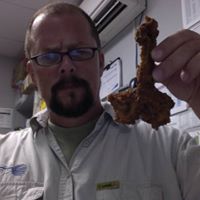Leaderboard
Popular Content
Showing content with the highest reputation on 11/24/2010 in Posts
-
Not sure what you mean by this? An infiltrated IV is going to have exactly the same effect as a missed IO - fluids and medications going into the tissues instead of the vein or osseous. It will just be in a different location. And just for the record an infiltrated IV can be extremely serious depending on what drugs have been extravasated. I have seen people lose limbs from infiltrated IVs. Found an interesting ScScandinavian retrospective IOstudy.1 point
-
Good advice from all, with the exception, and I apologize that I'm going to bag on you a bitAmb21, of pumping the cuff up to 200 before beginning to listen.Try it, it hurts! Then imagine the frail muscles and tendons of the children or older folks that you will often be running on. That's the easy way, but it's also the lazy way. As is watching the needle jump. Every fiber of my body says that there should be a dependable relationship between the jumping of the needle and the auscultated sounds, and though I continue to try and give some validity to my intuition, I remain unable to do so. Also, if you're using the stethoscope provided by your company I want you to stop what you're doing, take that $12 dual lumen piece of shit that seems to be in every ambulance and run in a smack your supervisor across the head with it. (Though in the short term this may not seem like sound advice, I think that you will find that EMS runs on stories, and the value of this story will pay WAY higher dividends over your career that the value of keeping this particular job. Trust me on this.) In my sometimes no so humble opinion dual lumen 'ears' have almost no place in an ambulance. I've used some that were really good, but when you're moving they just give way too much random noise for you to learn with. You need to back things up now, make them easier, and then you can throw foolish obstacles into your path. Now is not the time for a dual lumen stethoscope. And as Herbie mentioned, regardless of your scope, make sure you know how to use it. Also, palping the artery is great advice. When he started they didn't have stethoscopes, they just had to put their ear at the crook of the elbow, so knowing the exact location of the artery was vital. Soon though, thank goodness, one of his partners saw an old movie (not so old then of course, but I've only see them on reruns) where someone spied on the people in the next hotel room by putting a glass against the wall and listening through it, and his practice was changed forever! (Don't tell anyone, but I'm convinced it's the reason for freakish 'roundness' of his ears to this day.) And lastly. This is not a skill that you should be learning in the back of an ambulance. You do not, not, not, not, practice new, sensitive skills under pressure if you can help it. You should be practicing this at home. Unless you are a complete asshole, of which I've seen no signs so far, you should have ample family and friends that will help. Quiet room, no tv, no radio, not during one of your Friday night parties, it should be very quiiiiiiiiiet. Palp the pulse as Herbie instructed, put your stethoscope on that spot and begin to inflate your cuff. As the cuff begins to put pressure on the artery it will get a little bit noisier for a few seconds before it gets quiet due to be occluded. Once it gets silent increase the pressure a few mmHg and then begin to release the pressure. Very Slowly at first! Ok..now this is the good part...As you slowly release the pressure you will begin to hear the heartbeat in your ears, right? Awesome! Now you've found a spot to auscultate...as you continue to release the pressure I want you to move your stethoscope around, in small movement, to use it like you might use a metal detector, seeing where the sounds get stronger, or weaker. Once you've found the loudest spot you've gone from A spot to THE spot. Even if you started out on THE spot, I still want you to move it around so you can see what it sounds like in different places, different distances from THE spot. What this should do is give you a feel for the underlying vascular anatomy, see? If you're like me when I was new I'd be trying to get a BP thinking "Oh God, please, please, please let me hear it!!" Hoping that the EMS Gods would send me the sounds I needed to do my job. Fuck that, I'm not asking, I'm going to take the information I need! It's been my experience that any time I truly needed the EMS Gods to send me the information that I needed to keep from looking like a complete shithead in front of a gazillion people (with seemingly nothing better to do than stare at me) that they simply laughed while making fart sounds with their hands in their arm pits. So I don't really trust them so much any more. Anyway. Babs is shopping, Dylan and I are done raking leaves and I had way too much time to write a bunch of crap that probably could have been said in three sentences, but reading it is the price you pay for asking questions on a forum with no real standards for who can reply. :-) Going to forgo the lung sounds for now as I have used up all of my spare time rambling, but others will give good advice I know, and if not then I'll throw in my two cents when I can. Good questions. Very brave to ask them here man...I have a lot of respect for that. Dwayne1 point
-
First step- palpate the brachial artery. I know this sounds silly, but many people simply guess as to where that pulse is actually located. Once you FEEL the pulse there, place the scope directly on it. Also good suggestions from others about having a good stethescope with a proper fit in your ears. Most scopes come with several sizes of ear pieces- choose the ones that fit you best. You also need to understand the difference between the bell and the diaphragm portions of the device. The bell side is used for low pitched sounds, the diaphragm portion for the high pitched ones. Make sure you are using the correct side- it's easy to have them flipped and never realize it. As soon as I put the ears on, without even looking at it, I tap the bell and diaphragm on to ensure I have the correct side in place- a habit I developed 30 years ago and still do to this day. Sometimes the head may be slightly turned- ie not locked into place, and you won't be able to hear a thing. Some places use electronic varieties, which can be useful in noisy settings like in an aeromed situation- or someone with bad ears. LOL As for lung sounds, it takes a lot of practice to become proficient. Listen to yourself and anyone else who will let you. Use both sides of the scope and see the differences in what you can hear and the quality of the sound. Remember to go back and forth on both sides of the chest and back- at the same levels- to compare and contrast what you hear. Different patient sizes/body types and medical conditions will also affect how well you can hear things. Good question. As the old saying goes- the only silly question is the one you did not ask. If you don't know, then how will you ever learn?1 point
-
With regards to IM naloxone having a slower uptake: this is not necessarily a bad thing. So long as adequate ventilation is ongoing there is all the time in the world to administer narcan. In fact I personally feel that this is a better route to take. Oxygenate well, let the narcan work slowly and you have a much happier patient at the end of it all. In 13 years I have never had an overdose come up angry or swinging. All the angry/swinging/puking ones I have seen or heard of seem to be a result of having a hypoxic head and a sudden blast of IV narcan to ruin their day. I like to take my time, utilize the opportunity to give my student or BLS crew some time to do some manual airway management (which is difficult and often poorly done) and bring them up slowly. That and treating the patient with respect by not cutting up their best (only?) clothes means that the overdoses I wake up tend to shake my hand and thank me for saving them.1 point
-
I know a guy from the "Sooke" station who is doing his ACP training at SAIT right now as well. You may know him, his name is Marcus Mcpherson. I use to work with at the mine site that I work at as a first aid attendant. Actually my cross shift is there right now for the next two days with your class I am assuming as a observer. He is wanting to take the course starting next September. Thanks for the post and the information. Good luck in you ACP training.1 point
-
Welcome to the city, eh! Don't be afraid to jump into a discussion. Always looking for fresh points of view and opinions. Fair warning- we have some real smart folks here, so you will need to properly defend yourself and your ideas.1 point
-
The PCP scope of practice in BC would be roughly equivalent to EMT-I85 (Emergency Medical Technician Intermediate 85 standard). The scope of education would be roughly equivalent to EMT-I99. The easiest way to remember it is for EMT-B think EMR, EMT-I think PCP, EMT-P think ACP. Strictly in terms of scope of practice. In terms of education things can vary wildly from place to place. I'm a mainlander from the southern interior myself. Currently I'm on an educational LOA doing my ACP training at SAIT in Calgary. My three year anniversary with BCAS will be the first of January. I started out working as an EMR in Lillooet (est. 700 calls a year) and lateralled to Merritt (est. 2700 calls a year) after 14 months and my PCP training. You will find plenty of good knowledgeable people around here to bounce ideas off of. Quite a few Canadians included. For some reason many of the Canadian members are from Alberta, a few from BC, a few from Saskatchewan, and a few from Ontario. The other provinces are not that well represented. I don't think I've ever come across someone from Quebec.1 point
-
Welcome to the City! Don't forget to click on chat, when there's some folks on board. We have quite a number of cool, well educated, folks from CehNehDeh! Always wanted to visit BC, myself. Enjoy the site, it can be a helpful tool for quick advice from different backgrounds and minds; or if you're just having a bad day.1 point
-
Welcome to the City, Brian! Lucky you to be living in Nanaimo, BC. Do you have to go to the mainland for the busier station? Good luck with the new job and position. Don't ever stop learning and keep your compassion no matter what. And of course...safety first above all else!! Hope you enjoy the City and learn and share your experiences. Some good folk on here. Have a great Thanksgiving (or is it already over in Canada? I can't remember.) and Holiday Season and keep safe (and warm!!!) Cheers Aussie.1 point





